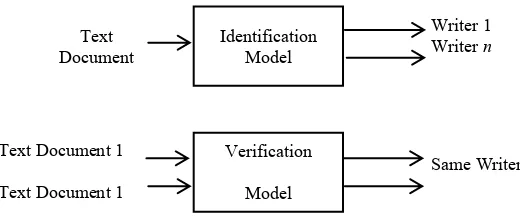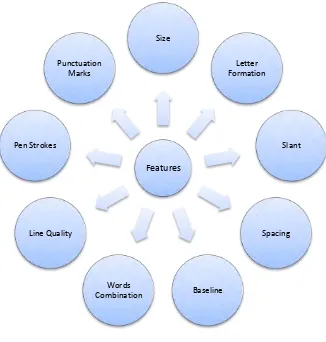Faculty of Information and Communication Technology
IMPROVED RANDOM FOREST FOR FEATURE SELECTION IN
WRITER IDENTIFICATION
Nooraziera Akmal Binti Sukor
Master of Science in Information and Communication Technology
IMPROVED RANDOM FOREST TREE FOR FEATURE SELECTION
IN WRITER IDENTIFICATION
NOORAZIERA AKMAL BINTI SUKOR
A thesis submitted
in fulfillment of the requirements for the degree of
Master of Science in Information and Communication Technology
Faculty of Information and Communication Technology
UNIVERSITI TEKNIKAL MALAYSIA MELAKA
DECLARATION
I declare that this thesis entitled “Improved Random Forest Tree for Feature Selection in Writer Identification” is the result of my own research except as cited in the references. The thesis has not been accepted for any degree and is not concurrently submitted in candidature of any other degree.
Signature :………....
Name : Nooraziera Akmal Binti Sukor
APPROVAL
I hereby declare that I have read this thesis and my opinion this thesis is sufficient in term of scope and quality for the award of Master of Science in Information and Communication Technology.
Signature : ………
Supervisor Name : PM Dr. Azah Kamilah Binti Draman @ Muda
DEDICATION
In the name of Allah swt, Beneficant, the Merciful All praise is due to Allah, the Lord of the Worlds
I dedicated my dissertation work and give special thanks to:
MY PARENTS
(Haji Sukor Bin Awang&HajahZainonBintiHitam)
MY SUPERVISOR
(Prof. MadyaDr. AzahKamilahBintiDraman @ Muda)
MY FRIEND (RimashadiraBintiRamlee)
MY SIBLINGS
(NoradilahBintiSukor, Noor HidayuBintiSukor, NadiyaSyakilaBintiSukor, NurulNazihahBintiSukor&AnuarHafiez Bin Sukor)
i ABSTRACT
ii ABSTRAK
ACKNOWLEDGEMENT
Foremost, I would like to express my sincere gratitude to my supervisor PM Dr. AzahKamilahBintiDraman@Muda for the continuous support for my Master study and research, for the patience, motivation, encouragement and immense knowledge. I would also express my gratitude to my co-supervisor, PuanNorazilahBintiDraman@Muda for the kind advice and valuable input.
My special thanks to my parentSukor Bin Awang and ZainonBintiHitam for giving birth to me at the first place and supporting me spiritually throughout my life. Also thankful to my siblings (NoradilahBintiSukor, Noor HidayuBintiSukor, NadiyaSyakilaBintiSukor, NurulNazihahBintiSukor and AnuarHafiez Bin Sukor) for all supports, encouragement and inspiration,
iv
1.1 Background of the Study 2
1.2 Statement of the Problem 4
1.3 Objectives of the Study 5
1.4 Assumptions and Hypothesis 6
2.2 Issue in Writer Identification 14
2.3 Writer Identification Framework 14
v
4. IMPROVED RANDOM FOREST TREE FOR FEATURE SELECTION 43
4.1 Introduction 43
4.2 Introduction of the Investigation 43
4.3 IRF tree for Feature Selection in WI 45
4.3.1 Random Forest tree 45
4.3.1.1 Variable Importance (VI) 47
4.3.1.2 Mean Absolute Error (MAE) 48
4.3.2 Random Forest tree Algorithm 50
4.4 Experiment and Result 51
4.5 Discretization Process 52
4.5.1 Result Analysis and Interpretation 61
4.5.1.1 Number of Feature 61
4.5.1.2 Classification Accuracy 63
4.6 Comparison with Other Technique 64
4.7 Summary 70
5. NEW FRAMEWORK FOR WRITER IDENTIFICATION USING
IMPROVED RANDOM FOREST TREE FEATURE SELECTION 72
5.0 Introduction 72
5.1 Introduction of the Investigation 72
5.2 Experimental Design 73
5.2.1 Standard Framework for WI 73
5.2.2 IRF tree Framework for WI 74
5.3 Experiment and Result 75
5.3.1 Analysis and Interpretation 79
vi
6. CONCLUSION AND FUTURE WORK 81
6.0 Introduction 81
6.1 Recommendation for Future Works 84
6.1.1 Writer Verification 84
6.1.2 Real Data Implementation 85
6.1.3 Feature Extraction 85
6.1.4 Classification 86
6.2 Conclusion 86
REFERENCES 88
vii
LIST OF TABLES
TABLE TITLE PAGE
1.1 Data used in the experiment 9
2.1 Comparison of Feature Selection Techniques 24 2.2 Comparison performances of feature selection methods 28
3.1 Overall Research Plan 41
4.1 Identification Accuracy Result (%) 49
4.2 Process selecting significant features 50
4.3 Comparison of RF algorithms 51
ix
4.1 Illustration of process selecting important feature 50
4.2 Writer Identification process 52
4.3 Proposed WI frameworks 52
4.4 Data used in the experiment 53
4.5 Result of Discretized Dataset Set A at execution #1 55 4.6 Result of Discretized Dataset Set B at execution #1 55 4.7 Result of Discretized Dataset Set C at execution #1 56 4.8 Result of Discretized Dataset Set D at execution #1 56 4.9 Result of Discretized Dataset Set E at execution #1 57 4.10 Result of Un-discretized Dataset Set A at execution #1 59 4.11 Result of Un-discretized Dataset Set B at execution #1 59 4.12 Result of Un-discretized Dataset Set C at execution #1 60 4.13 Result of Un-discretized Dataset Set D at execution #1 60 4.14 Result of Un-discretized Dataset Set E at execution #1 61
5.1 Traditional framework for WI 74
x
LIST OF ABBREVIATIONS
HI - Handwriting Identification
HR - Handwriting Recognition
WI - Writer Identification WV - Writer Verification
RF - Random Forest
VI - Variable Importance
MSE - Mean Squared Error
OOB - Out-Of-Bag
CART - Classification and Regression Tree UMI - United Moment Invariant
SFS - Sequential Forward Selection
SFFS - Sequential Forward Floating Selection
CI-SFFS - Computationally Inexpensive Sequential Forward Floating Selection MIC - Modiffied Immune Classifier
CFS - Correlation-based Feature Selection LVF - Las Vegas Filter
FCBF - Fast Correlation-based Filter
SMFS - Significance Measurement Feature Selection NSA - Negative Selection Algorithm
NBayes - Naïve Bayes
xi
LIST OF SYMBOLS
- Training set
� - Tree
M - Bagging
- Prediction Error
� - Impurity Measurement
- Number of Sample
- Prediction
B - Number of Tree
x’ - Sample Data
xp - Predictor
êk - Prediction Error
ê - Out-Of-Bag Error
� - average prediction for i th observation
MSEOOB - squared error for OOB
� 2 - standard deviation taken over tree computed with n as advisor
xii
LIST OF APPENDICES
APPENDIX TITLE PAGE
A A comparative Study of Tree Structure Based Method for Feature 96 Selection in Handwriting Identification
xiii
LIST OF PUBLICATIONS
SUKOR N.A., MUDA, A. K., MUDA, N. A.&CHOO, Y.-H 2014 A Comparative Study of Tree-based Structure Methods for Handwriting Identification.First International Conference on Advanced Data and Information Enginerring (DaEng-2013) Lecture Notes
in Electrical Engineering Volume 285, 2014, pp 269-276
CHAPTER 1
INTRODUCTION
1.0 Introduction
Writer Identification (WI) problems was introduced long time ago and various studies were conducted using pattern recognition technique (Srihariet al., 2001; Schlapbach and Bunke, 2004; Zhang and Srihari, 2003; Zhu et al, 2004) where the result is to identify the author of a handwritten document. The uniqueness and the individuality of a handwriting style can be used to identify the significant features in identifying the original owner of the handwriting. There are some applications that required WI performances such as identifying the writer on legal papers by signature, handling threat letters or determination of an old or historical manuscript. WI studies contribute a great importance towards the criminal justice system and have been widely explored in forensic handwriting analysis (Somayaet al., 2008; Srihariet al., 2006)
2 1.1 Background of the Study
Handwriting Analysis is divided into Handwriting Identification (HI) and Handwriting Recognition (HR). HI is used to identify the writer of the given handwritten document while HR deals with the content and meaning of handwritten text. There are two models in HI which are writer identification (WI) and writer verification (WV), as shown in Figure 1.1. WI is the process to determine who is the writer among the candidates for the given handwriting samples (focused in this study) while WV deals with a given samples of handwriting and then determine whether the sample belongs to the same writer or different writer among the candidates
Figure 1.1: Handwriting Identification Model
Handwriting has an individualistic nature where each individual has a natural variation where no two people have the exact handwriting style (Srihariet al., 2006). In the forensic field, handwriting is one of evidence that is most involved in cases such as forgery, murder and etc. This is because HI is a personal biometric attribute and is considered unique to every person (Srihariet al., 2001; Srihari, et al., 2002; Zhang and Srihari, 2003). The shapes and the style of writing can be used as biometric features for authenticating and identifying a person (Srihariet al., 2006).
3
Each of the features is different due to the various handwriting styles and some do not provide useful information in WI. This will in turn lead to interrupting the performance of the classifier, thus creating a challenge in the identification process. To overcome this problem, feature selection process will be applied to select the most significant of features thus increasing the classification accuracy (Muda et al., 2011). This is due to the feature selection process where only significant features will be used in the classification process and thus can minimize the complexity processing while improving the classification accuracy. This leads to the main issue in Writer Identification which is how to acquire the most significant of features reflected in the author's handwriting (Srihari et al., 2002; Shen
et al., 2002).
There have been many studies done on feature selection process in handwriting’s field such as: Feature Selection using Genetic Algorithm for Handwritten Character (G. Kim and S. Kim, 2000), Feature Selection for ensemble applied to Handwritten Recognition (L.S. Oliveira, 2006), A Feature Selection Algorithm for Handwritten Character Recognition (L. Cordella, 2008), Feature Selection for Recognizing Handwritten Arabic Letters (A. Gheith et al., 2010) and a GA-based Feature Selection Approach with an application to Handwritten Character Recognition (C. De Stefano et al., 2013). Also the research of Comparative Study of Feature Selection Method for Authorship Invariances in Writer Identification (Pratama S. F et al., 2012) and Comparative Study of Feature Selection Method for Writer Identification (Pratama S. F et al., 2013)
4
method in the handwriting domain. This study will explore how embedded method works on feature selection process in WI and focuses on tree-based structure.
1.2 Statement of the Problem
Handwriting is individualistic where every person has his/her own handwriting styles. All features from following criteria affect the individuality of handwriting which makes ones’ handwriting differ from another:
5
Some The primary problem statement for this research is:
“How to obtain the effective tree structure in selecting the significant and
unique features of handwriting for Writer Identification?”
In order to complement the primary problem statement, there are three secondary problem statements to be considered:
1) How to identify the significant features in Writer Identification?
2) How to ensure the effective framework for feature selection in Writer features will interrupt the classification process and increase the complexity of WI process (Pratama et al., 2007). Hence, feature selection process is important to eliminate these irrelevant features. During feature selection process, only relevant features will be obtained. Relevant features are unique to individual and give a major impact to the one’s handwriting. The performances of feature selection process will be measured against the number of selected features and classification accuracy. Time complexity is excluded as it is not an issue in WI domain (Pratamaet al., 2007).
6
the purpose of producing minimal subset of features while giving high classification accuracy. It can be achieved with the following objectives:
1. To propose an algorithm of tree structure-based for feature selection in WI. 2. To propose a framework of tree structure-based technique for feature
selection in WI.
1.4 Assumptions and Hypothesis
During this study, an experiment regarding WI was carried out. This experiment involved a dataset from IAM handwriting database as it is a benchmarked dataset used by other researchers in the handwriting field.
Filter method, wrapper method and embedded method are the most popular feature selection methods that are usually implemented in WI domain. However, in this study tree-based structure of embedded method will be further explored and Random Forest (RF) tree is selected as feature selection method in WI process. RF tree works by scoring the importance features and find the absolute error of features using method of Variable Importance (VI) and Mean Absolute Error (MAE). Relevant features means high value of VI. In WI, the variance for intra-class (same writer) must be lower than inter-class (different writer) (He et al., 2008; Srihari et al., 2001; Zois and Anastassopoulos, 2000) which is indicates accuracy to the real author

